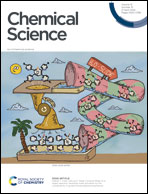A novel hydrophobic carborane-hybrid microporous material for reversed C2H6 adsorption and efficient C2H4/C2H6 separation under humid conditions†
Abstract
Since ethylene (C2H4) is important feedstock in the chemical industry, developing economical and energy-efficient adsorption separation techniques based on ethane (C2H6)-selective adsorbents to replace the energy-intensive cryogenic distillation is highly demanded, which however remains a daunting challenge. While previous anionic boron cluster hybrid microporous materials display C2H4-selective features, we herein reported that the incorporation of a neutral para-carborane backbone and aliphatic 1,4-diazabicyclo[2.2.2]octane (DABCO) enables the reversed adsorption of C2H6 over C2H4. The generated carborane-hybrid microporous material ZNU-10 (ZNU = Zhejiang Normal University) is highly stable in humid air and maintains good C2H6/C2H4 separation performance under high humidity. Gas loaded single crystal structure and density-functional theory (DFT) calculations revealed that the weakly polarized carborane and DABCO within ZNU-10 induce more specific C–Hδ+⋯Hδ−–B dihydrogen bonds and other van der Waals interactions with C2H6, while the suitable pore space allows the high C2H6 uptake. Approximately 14.5 L kg−1 of polymer grade C2H4 can be produced from simulated C2H6/C2H4 (v/v 10/90) mixtures under ambient conditions in a single step, comparable to those of many popular materials.



 Please wait while we load your content...
Please wait while we load your content...